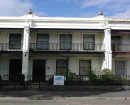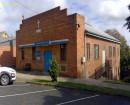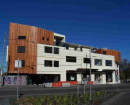Cargo Sheds South Wharf 1 & 2 & 4-9
South Wharf Road, SOUTHBANK VIC 3006 - Property No B1313
-
Add to tour
You must log in to do that.
-
Share
-
Shortlist place
You must log in to do that.
- Download report


Statement of Significance
The wharf sheds between the Polly Woodside and Johnson Street Bridge are the oldest and most intact group on the Yarra, and represent the most primitive stage in port development. The first wharves were simple riverside quays which progressively spread downstream and became more elaborate with construction of enclosed docks such as Spencer and Victoria Docks. The closure of the river to navigation above Spencer Street led to the eradication of all signs of wharfage in Melbourne's original port area. The complex of sheds and wharves is therefore significant as the last example of early river front wharfage and shipping sheds remaining in their original context. Their survival facilitates comtemporary interpretation of 19th century shipping and its geographical relationship with Melbourne at the time and the industrial development of South Melbourne. They also offer insights into the founding years of the Melbourne Harbour Trust and the historical development through to the 1930s. Bearing in mind the historical and cultural traditions of the South Bank area, it is essential that the maritime character of the area be preserved. Otherwise an important part of Melbourne's heritage will be lost. The retention of the physical integrity of the sheds and wharves is essential if the significance of the Yarra River as a once great shipping port is to survive. Statement of Significance for No 9 Shed. The remains of No 9 Shed, South Wharf, are significant as the oldest surviving in situ shipping shed east of the Charles Grimes Bridge. As such this structure recalls the earliest phase in the development of these wharves by the Melbourne Harbour Trust and also recalls their use for overseas shipping during the nineteenth and first half of the present century. It compares with the contemporary and slightly earlier Nos. 1-2 sheds (1882-1891) but of course is different to the extent that its gabled roof contrasts with their bowstring truss roof. The shed design is also different to nearby sheds 4-8 which are of a later design with roller shutter doors and angle iron roof trusses. A comparison with sheds 8 and 15 at Victoria Dock (the earliest sheds at this dock, c.1915) is instructive, showing trusses of later design with steel straps instead of tie rods in the lower chords, and variations in timber details consistent with the periods of construction. The No. 9 shed and wharf are therefore significant to the extent that they facilitate contemporary interpretation of nineteenth century shipping and its geographical relationship with Melbourne at the time. They also offer insights into the founding years of the Melbourne Harbour Trust. See also File No 1313 (part 3) Shed 1 demolished c.1986 Shed 2 relocated to Duke & Orr Dry Dock FN 2895 Also Pollly Woodside FN 2775
Classified: 12/09/1963
more elaborate with construction of enclosed docks such as Spencer and Victoria Docks. The closure of the river to navigation above Spencer Street led to the eradication of all signs of wharfage in Melbourne's original port area.
The complex of sheds and wharves is therefore significant as the last example of early river front wharfage and shipping sheds remaining in their original context. Their survival facilitates comtemporary interpretation of 19th century shipping and its geographical relationship with Melbourne at the time and the industrial development of South Melbourne. They also offer insights into the founding years of the Melbourne Harbour Trust and the historical development through to the 1930s.
Bearing in mind the historical and cultural traditions of the South Bank area, it is essential that the maritime character of the area be preserved. Otherwise an important part of Melbourne's heritage will be lost. The retention of the physical integrity of the sheds and wharves is essential if the significance of the Yarra River as a once great shipping port is to survive.
Statement of Significance for No 9 Shed.
The remains of No 9 Shed, South Wharf, are significant as the oldest surviving in situ shipping shed east of the Charles Grimes Bridge. As such this structure recalls the earliest phase in the development of these wharves by the Melbourne Harbour Trust and also recalls their use for overseas shipping during the nineteenth and first half of the present century. It compares with the contemporary and slightly earlier Nos. 1-2 sheds (1882-1891) but of course is different to the extent that its gabled roof contrasts with their bowstring truss roof.
The shed design is also different to nearby sheds 4-8 which are of a later design with roller shutter doors and angle iron roof trusses. A comparison with sheds 8 and 15 at Victoria Dock (the earliest sheds at this dock, c.1915) is instructive, showing trusses of later design with steel straps instead of tie rods in the lower chords, and variations in timber details consistent with the periods of construction.
The No. 9 shed and wharf are therefore significant to the extent that they facilitate contemporary interpretation of nineteenth century shipping and its geographical relationship with Melbourne at the time. They also offer insights into the founding years of the Melbourne Harbour Trust. See also File No 1313 (part 3)
Shed 1 demolished c.1986
Shed 2 relocated to Duke & Orr Dry Dock FN 2895
Also Pollly Woodside FN 2775
-
-
-
-
OLD BOURKE STREET WEST POLICE STATION AND CELL BLOCK
 Victorian Heritage Register H0655
Victorian Heritage Register H0655 -
ST AUGUSTINES CATHOLIC CHURCH AND FORMER SCHOOL
 Victorian Heritage Register H0002
Victorian Heritage Register H0002 -
FORMER MELBOURNE TRAMWAY AND OMNIBUS COMPANY BUILDING
 Victorian Heritage Register H0785
Victorian Heritage Register H0785
-
-









